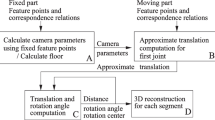Abstract
Articulated objects like doors, drawers, valves, and tools are pervasive in our everyday unstructured dynamic environments. Articulation models describe the joint nature between the different parts of an articulated object. As most of these objects are passive, a robot has to interact with them to infer all the articulation models to understand the object topology. We present a general algorithm to estimate the inherent articulation models by exploiting the momentum of the articulated system along with the interaction wrench while manipulating the object. We validate our approach with experiments in a simulation environment.
Access this chapter
Tax calculation will be finalised at checkout
Purchases are for personal use only
Similar content being viewed by others
References
Nagatani, K., Yuta, S.I.: An experiment on opening-door-behavior by an autonomous mobile robot with a manipulator. In: Proceedings of 1995 IEEE/RSJ International Conference on Intelligent Robots and Systems 1995, Human Robot Interaction and Cooperative Robots, vol. 2, pp. 45–50. IEEE (1995)
Niemeyer, G., Slotine, J.-J.E.: A simple strategy for opening an unknown door. In: Proceedings of 1997 IEEE International Conference on Robotics and Automation, vol. 2, pp. 1448–1453. IEEE (1997)
Jain, A., Kemp, C.C.: Pulling open novel doors and drawers with equilibrium point control. In: 9th IEEE-RAS International Conference on Humanoid Robots, Humanoids 2009, pp. 498–505. IEEE (2009)
Karayiannidis, Y., Smith, C., Barrientos, F.E.V., Ögren, P., Kragic, D.: An adaptive control approach for opening doors and drawers under uncertainties. IEEE Trans. Robot. 32(1), 161–175 (2016)
Katz, D., Brock, O.: Interactive perception: closing the gap between action and perception. In: ICRA 2007 Workshop: From Features to Actions-Unifying Perspectives in Computational and Robot Vision (2007)
Katz, D., Brock, O.: Manipulating articulated objects with interactive perception. In: 2008 IEEE International Conference on Robotics and Automation, ICRA 2008, pp. 272–277. IEEE (2008)
Katz, D., Pyuro, Y., Brock, O.: Learning to manipulate articulated objects in unstructured environments using a grounded relational representation. Robot.: Sci. Syst. IV, 254 (2009)
Sturm, J., Pradeep, V., Stachniss, C., Plagemann, C., Konolige, K., Burgard, W.: Learning kinematic models for articulated objects. In: IJCAI, pp. 1851–1856 (2009)
Sturm, J., Konolige, K., Stachniss, C., Burgard, W.: 3D pose estimation, tracking and model learning of articulated objects from dense depth video using projected texture stereo. In: RGB-D: Advanced Reasoning with Depth Cameras Workshop, RSS (2010)
Sturm, J., Stachniss, C., Burgard, W.: A probabilistic framework for learning kinematic models of articulated objects. J. Artif. Intell. Res. 41, 477–526 (2011)
Hausman, K., Niekum, S., Osentoski, S., Sukhatme, G.S.: Active articulation model estimation through interactive perception. In: 2015 IEEE International Conference on Robotics and Automation (ICRA), pp. 3305–3312. IEEE (2015)
Otte, S., Kulick, J., Toussaint, M., Brock, O.: Entropy-based strategies for physical exploration of the environment’s degrees of freedom. In: 2014 IEEE/RSJ International Conference on Intelligent Robots and Systems (IROS 2014), pp. 615–622. IEEE (2014)
Martin, R.M., Brock, O.: Online interactive perception of articulated objects with multi-level recursive estimation based on task-specific priors. In: 2014 IEEE/RSJ International Conference on Intelligent Robots and Systems (IROS 2014), pp. 2494–2501. IEEE (2014)
Martın-Martın, R., Brock, O.: Building kinematic and dynamic models of articulated objects with multi-modal interactive perception. In: AAAI Symposium on Interactive Multi-Sensory Object Perception for Embodied Agents. AAAI (2017)
Featherstone, R.: Rigid Body Dynamics Algorithms. Springer (2014)
Featherstone, R.: Rigid Body Dynamics Algorithms, Chapter 3, pp. 49–50. Springer (2014)
Featherstone, R.: Rigid Body Dynamics Algorithms, chapter 2, pp. 35–36. Springer (2014)
Metta, G., Natale, L., Nori, F., Sandini, G., Vernon, D., Fadiga, L., Von Hofsten, C., Rosander, K., Lopes, M., Santos-Victor, J., et al.: The icub humanoid robot: an open-systems platform for research in cognitive development. Neural Netw. 23(8–9), 1125–1134 (2010)
Natale, L., Bartolozzi, C., Pucci, D., Wykowska, A., Mettaicub, G.: The not-yet-finished story of building a robot child. Sci. Robot. 2(13), eaaq1026 (2017)
Nori, F., Traversaro, S., Eljaik, J., Romano, F., Del Prete, A., Pucci, D.: icub whole-body control through force regulation on rigid non-coplanar contacts. Front. Robot. AI 2, 6 (2015)
Hoffman, M., Traversaro, S., Rocchi, A., Ferrati, M., Settimi, A., Romano, F., Natale, L., Bicchi, A., Nori, F., Tsagarakis, N.G.: Yarp based plugins for gazebo simulator. In: International Workshop on Modelling and Simulation for Autonomous Systems, pp. 333–346. Springer (2014)
Acknowledgments
This work is supported by PACE project which has received funding from the European Union’s Horizon 2020 research and innovation programme under the Marie Sklodwska-Curie grant agreement No 642961.
Author information
Authors and Affiliations
Corresponding author
Editor information
Editors and Affiliations
Rights and permissions
Copyright information
© 2020 Springer Nature Switzerland AG
About this paper
Cite this paper
Tirupachuri, Y., Traversaro, S., Nori, F., Pucci, D. (2020). Momentum-Based Topology Estimation of Articulated Objects. In: Bi, Y., Bhatia, R., Kapoor, S. (eds) Intelligent Systems and Applications. IntelliSys 2019. Advances in Intelligent Systems and Computing, vol 1038. Springer, Cham. https://doi.org/10.1007/978-3-030-29513-4_79
Download citation
DOI: https://doi.org/10.1007/978-3-030-29513-4_79
Published:
Publisher Name: Springer, Cham
Print ISBN: 978-3-030-29512-7
Online ISBN: 978-3-030-29513-4
eBook Packages: Intelligent Technologies and RoboticsIntelligent Technologies and Robotics (R0)




